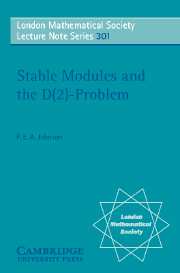Book contents
- Frontmatter
- Contents
- Acknowledgements
- Introduction
- 1 Orders in semisimple algebras
- 2 Representation theory of finite groups
- 3 Stable modules and cancellation theorems
- 4 Relative homological algebra
- 5 The derived category of a finite group
- 6 k-invariants
- 7 Groups of periodic cohomology
- 8 Algebraic homotopy theory
- 9 Stability theorems
- 10 The D(2)-problem
- 11 Poincaré 3-complexes
- Appendix A The D(2)-property for free groups
- Appendix B The Realization Theorem
- References
- Index
8 - Algebraic homotopy theory
Published online by Cambridge University Press: 04 August 2010
- Frontmatter
- Contents
- Acknowledgements
- Introduction
- 1 Orders in semisimple algebras
- 2 Representation theory of finite groups
- 3 Stable modules and cancellation theorems
- 4 Relative homological algebra
- 5 The derived category of a finite group
- 6 k-invariants
- 7 Groups of periodic cohomology
- 8 Algebraic homotopy theory
- 9 Stability theorems
- 10 The D(2)-problem
- 11 Poincaré 3-complexes
- Appendix A The D(2)-property for free groups
- Appendix B The Realization Theorem
- References
- Index
Summary
In this chapter, we encounter homotopy theory in both its geometric and algebraic aspects. We begin by reviewing the homotopy theory of projective chain complexes, as outlined, for example, by Wall in [69]. To ensure consistency of notation, we start from elementary considerations. One of our primary aims is to introduce the finiteness obstruction x of Swan [58] and Wall [68] which, viewed algebraically, detects when a projective chain complex is homotopy equivalent to a free chain complex.
If X is a CW complex we say that X is reduced when it has a single 0-cell. Clearly a reduced complex is automatically connected. If X is a connected CW complex and T ∪ X(1) is a maximal tree then the quotient X/T is a reduced CW complex which is homotopy equivalent to X. Without further mention we assume that in a reduced complex the basepoint is the unique 0-cell, and allow ourselves to write π1(X) rather than π1(X, *).
We shall fix a finitely presented group G, described in some specific way, and consider all CW complexes with the fundamental group isomorphic to G. In working with distinct spaces whose fundamental groups though isomorphic are nevertheless distinct, it is necessary to keep track of the different ways elements in the various fundamental groups can be identified. We do this by assuming at the outset that each CW complex X under consideration is given a specific isomorphism (sometimes called a polarization), px : π1(X, *) → G.
- Type
- Chapter
- Information
- Stable Modules and the D(2)-Problem , pp. 171 - 192Publisher: Cambridge University PressPrint publication year: 2003



